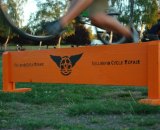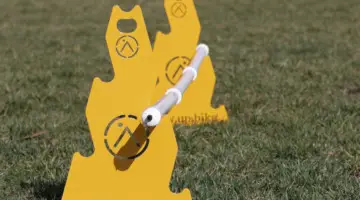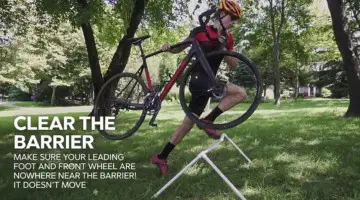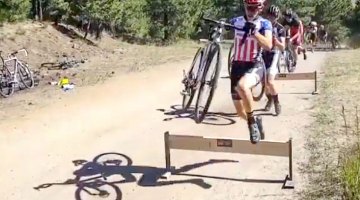One of the best cyclocross skills to learn as a new racer is learning how to take “transitions.” (Not just barriers: transitions can mean a lot of different obstacles.) In this article, Erik Tonkin of Sellwood Cycles writes about how to practice dismounts so by the time race season starts, you’re a pro at dismounting for obstacles.
by Erik Tonkin
Once I’ve actually done a few early season ’cross races and have been forced (however reluctantly!) to ride with some modicum of form, the technical point that asserts itself is time. I’m reminded that I must take enough time to comfortably dismount before the transition zone — a barrier, double barriers, a six-pack of ‘em, a run-up, a sand pit, a mud bog, or anything that forces you to get off your bike.
The point is to be calm and relaxed. You have to ride your bike hard — really hard — for the vast majority of a ’cross race. Use the transition zones — where your specific skills as a ‘crosser come to the fore — as places to cheat time and even rest. Here’s how you do it: the space you need to properly set up for your dismount should increase as your speed increases. If you’re travelling at 15 miles per hour, you need to dismount earlier than if traveling ten miles per hour. Again, more space will feel like more time, but you will not actually lose any time.
Practice this in a flat grass field. Set up a barrier or some type of physical marker that denotes the transition zone. Then, set a second marker in front of the first. This is your “dismount marker,” the spot that marks a distance you deem appropriate for a safe, controlled dismount. Now, ride to the “dismount marker” and begin the proper cyclocross dismount we all practice. Once you’re safely off the bike, note how many steps you have underfoot before going over the barrier. Now, do the same thing, but sprint at that dismount marker. I mean, get out of the saddle and take a few hard pedal strokes toward that marker! You should be going fast here. I bet more space will be required to safely dismount your bike, so don’t be surprised if you run out of room. Do it again, but re-set the dismount marker further in front of the barrier. You want to allow yourself enough steps before the barrier — or any transition zone — to get comfortable on your feet, to get your cadence down, to get your run on.
This fast approach can still be a calm approach … if you give yourself enough space. Racing hard at that dismount marker, beginning your dismount early, and coasting at a high rate of speed as you go through the dismount process is faster, more controlled, and more efficient than pedaling slowly and hopping off right before the barrier. Again, pedaling your bike is not necessarily faster than coasting; being on your bike is not necessarily faster than being off it. Giving yourself more space can actually save you a lot time. You’ll probably avoid some crashes and simply save a lot of energy, too.
Think of the start of a race, when you’re surrounded by too many other fellow ’crossers, all squeezed in between the course tape and rushing en masse toward the first barrier. Give yourself the space and time to go through the transition zone quickly and calmly. You’ll probably be no worse for wear (well, less worse, anyway — it is ’cross after all), and you just might beat that rider next to you because of it!
Good luck and have fun, and thanks for reading.





























